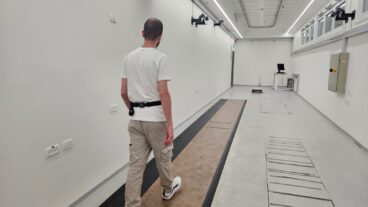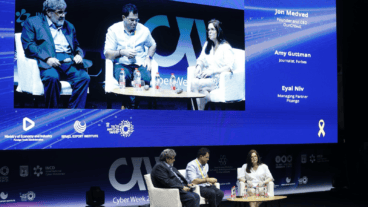‘In the past, a person had to see a TV ad only three times for it to be effective,” says Minicom’s Mika Yehezkeli. ‘Today, the same ad has to be played to someone about forty times for them to actually ‘see’ it.’A flashy new Israeli technology is exposing itself across America.
It is a new kind of advertising medium that is mushrooming in major US retail stores. Thanks to Minicom Advanced Systems Ltd. Companies such as Walmart and Albertsons are able to deliver targeted advertising and promotions that match today’s media-hungry consumers, whose tastes can literally change with the weather.
The medium is called digital signage. Two-for-one specials and the latest nuggets of news can be sent from one computer and delivered on-the-fly to hundreds of different plasma screens and monitors scattered not only across stores, but also banks, bars, airports and subway systems.
“Seventy percent of purchase decisions are made on the spot,” Mika Yehezkeli, Minicom’s marketing manager tells ISRAEL21c. “Digital signs have been proven to really rock compared to static forms. Moving signs keeps peoples’ attention and this new media has created a lot of excitement.”
Digital signage, she says, is on the up and up because retailers now understand that traditional forms of advertising such as billboards, banners and TV ads are passé.
“In the past, a person had to see a TV ad only three times for it to be effective,” notes Yehezkeli. “Today, the same ad has to be played to someone about forty times for them to actually ‘see’ it. People have Tivo and scan through commercials. Others are simply immune to commercials. As for banner ads on the internet, people have simply learned to ignore them.”
Minicom isn’t a new Israeli startup. It has over 100 employees in its modern Jerusalem headquarters, and has been in business for about 20 years. The company is accustomed to being a behind-the-scenes player for high-profile clients around the world: the US Navy, the US Federal Government, Merrill Lynch, and Hilton Hotels. Other clients include France Telecom, HP, IBM, JP Morgan, Language Training Canada, and Oracle Corp.
Yehezkeli talks marketing, but Minicom is mainly a technical parts company which supplies solutions to resellers who need to make digital signs work.
“For digital signage, you could say we are one of the leaders,” says Amir Ginossar, a product manager at Minicom. “We are the last mile, connecting between players (where the content is located) and screens. We can split content to multiple screens and be compatible with any kind of screen or computer, but we’re dealing mainly with computer VGA signals.”
VGA stands for video graphics array. It is a graphics display system developed for PCs by IBM. The last mile is telecommunications-speak for the final leg of connectivity between a digital device and its display. Have you looked at that scary clump of wires behind your computer lately? Imagine that sort of chaos times a thousand, or more. Sorting out wires for large stores, hotels and mass transit hubs isn’t easy.
Minicom didn’t figure out the solution over night. For years, it had been working with communications media, mainly making digital learning centers in classrooms. The company says it offers a way to connect a central computer hub to tens, hundreds and up to thousands of monitors. The problem can’t be solved by simply connecting CAT5 computer cables and extension cords, because when rich media signals travel distances they get mixed with interference and end up all muddled.
Minicom’s solution, the Video-Over-CAT5 amplifies and transmits high quality video from any type of player to an electronic display device over a regular CAT5 cable up to 110m from the player to a distant monitor.
“One of the nice things about Minicom is that we are not so complicated,” says Ginossar. “A transmitter sits next to the player and we multiply the signal. We can send this signal up to 1000 monitors with no interference.”
Doing it digitally means that entertainment, news and advertisements can be added basically any time the weather changes. For example, Walmart can advertise a sale on umbrellas when the forecast predicts rain and bathing suits when the forecast predicts sun. “It is about providing the right people, at the right time, with the right information,” says Ginossar.
If parts malfunction, more than 95% of all technical issues can be fixed without on-site maintenance, a huge cost saver to the end-user.
Digital signage is not to be confused with digital signatures, explains Yehezkeli who believes that not so many people are really aware of what digital signage means or how it can affect their lives.
For example, when her daughter needed to write a winning term paper on the digital culture for college, the answer was obvious. “I told her to write about the role of digital signage for new media,” recalls Yehezkeli.
“She sent an email to her professor at the communications college and he said that digital signatures ‘(codes to verify the identity of an emailer)’ aren’t exactly a new concept.” The professor’s mistake helped Yehezkeli realize that her work was really new. However, she also notes that even if you haven’t heard the lingo, chances are you have already been exposed to digital signage.
Digital signage is a younger business development for Minicom. American clients, says Ginossar, are still mainly buying another main product, the KVM (keyboard, video and mouse) solution. The product in some ways works opposite to what Minicom is doing for Walmart and Albertsons. KVM is used when many computers and servers need to connect at one point, such as in data centers at banks.
David Zucker, account manager for Minicom in the US, says one main KVM customer is Wrightline. “They supply to the military and any big customers you could think of,” says Zucker. “They supply KVM solutions to the Naval Undersea Warfare Center of the US Navy. You know, where they do their launches.” The center is the Navy’s research, development and fleet support center for weapons systems connected with undersea warfare.
“Our products are probably throughout bars and hotel lobbies in America too,” says Zucker.
Whether it is sending one signal to many computers or sending many computers to one monitor, Minicom is working hard to make sure that our digital lives run smoothly. So the next time you see a digital sign in a Walmart store, in the a bank, or while having a drink at a local bar – what you are looking at may be powered by Israeli technology.












